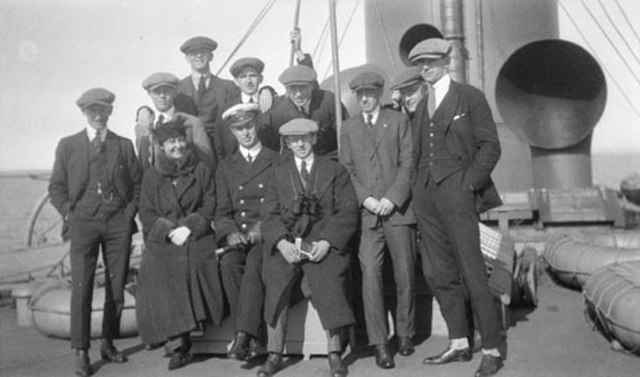Ice hockey at the 1920 Summer Olympics
Ice hockey was introduced to the Olympic Games at the 1920 Summer Olympics in Antwerp. The tournament also served as the first World Championships. The matches were played between April 23 and April 29, 1920. Canada, represented by the Winnipeg Falcons, won the gold medal. The silver went to the United States and Czechoslovakia took the bronze.
Picture of the Gold Medal-winning Winnipeg Falcons taken en route to the 1920 Olympics (photo includes an unidentified ships' officer and a woman)
Palais de Glace d'Anvers ice rink where the ice hockey tournament was held.
Winnipeg Falcons team photo at the 1920 Summer Olympics
Ice hockey is a team sport played on ice skates, usually on an ice skating rink with lines and markings specific to the sport. It belongs to a family of sports called hockey. In ice hockey, two opposing teams use ice hockey sticks to control, advance, and shoot a closed, vulcanized, rubber disc called a "puck" into the other team's goal. Each goal is worth one point. The team which scores the most goals is declared the winner. In a formal game, each team has six skaters on the ice at a time, barring any penalties, one of whom is the goaltender. Ice hockey is a full contact sport, and is considered to be one of the more physically demanding team sports. It is distinct from field hockey, in which players move a ball around a non-frozen pitch using field hockey sticks.
An ice hockey forward (Bryan Rust of the Pittsburgh Penguins) shoots toward a net defended by a goaltender (Braden Holtby of the Washington Capitals).
VTB Arena is an example of an indoor ice hockey arena. The arena is used by HC Dynamo Moscow.
Players from the South Carolina Stingrays perform a line change. A line change is a substitution of an entire line at once.
Scoreboard for a hockey game during the fourth period. If a game is tied at the end of the third period, several leagues and tournaments have teams play additional sudden death overtime periods.







